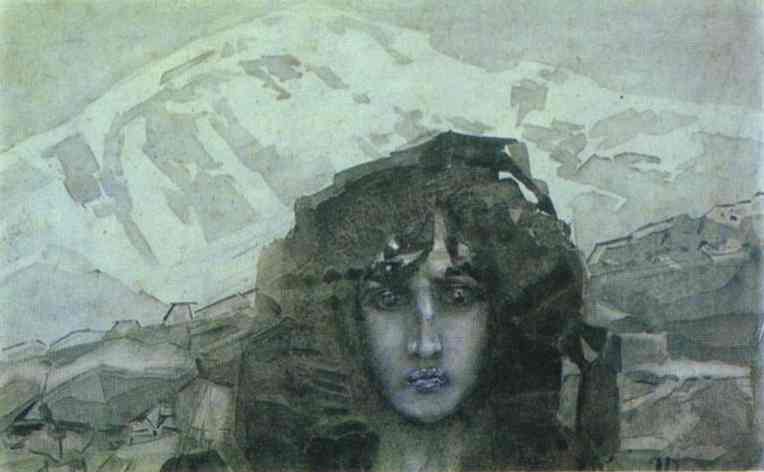Head of Demon Mikhail Vrubel (1856-1910)
Mikhail Vrubel – Head of Demon
Edit attribution
Download full size: 764×472 px (0,0 Mb)
Painter: Mikhail Vrubel
The year Vrubel moved to Moscow, he became acquainted with Konchalovsky, a literary man known at the time, who was working on an edition of Lermontov’s works. He ordered from the artist several illustrations for the poet’s works - including "Demon." All the illustrations for the poem (although judging by the richness of the palette, they were more like full-fledged paintings) were done in black watercolor and were distinguished by their semantic completeness. Vrubel worked especially carefully on "The Demon’s Head", because the picture was given an important role - to be the title picture.
Description of Mikhail Vrubel’s painting The Head of the Demon
The year Vrubel moved to Moscow, he became acquainted with Konchalovsky, a literary man known at the time, who was working on an edition of Lermontov’s works. He ordered from the artist several illustrations for the poet’s works - including "Demon."
All the illustrations for the poem (although judging by the richness of the palette, they were more like full-fledged paintings) were done in black watercolor and were distinguished by their semantic completeness.
Vrubel worked especially carefully on "The Demon’s Head", because the picture was given an important role - to be the title picture. Contemporaries were attracted by the artist’s unusual interpretation of the main character of the poem, which, as can be seen from the image, was not at all mournful and suffering.
On the contrary, the Demon is full of energy of thought, he is ready again and again to ask questions, seeks to find a solution to eternal questions. The face seems to burn with flame from within - you can see it in the eyes and lips of the Demon. The latter especially capture the viewer’s attention.
Another peculiarity of the image of the main character is Vrubel’s combination of female and male characters, which should only emphasize the universality and archetypicality of the image. Also note that the background on which the face of the Demon is placed is somewhat reminiscent of the paintings of another symbolist painter, Klimt.
It is hardly surprising that the hero of Lermontov’s poem interested the artist so much that he subconsciously transferred certain traits of the Demon onto himself - his search for metaphysical solutions to the eternal riddles of existence. Unfortunately, modern critics did not understand Vrubel’s illustrations.
The artist has been accused of being crude and ugly in his lines, of leaving Lermontov’s idea completely incomprehensible to him. It has now become commonplace to recognize paintings depicting the Demon (this painting is one of them) as the pinnacle of Vrubel’s work.
Кому понравилось
Пожалуйста, подождите
На эту операцию может потребоваться несколько секунд.
Информация появится в новом окне,
если открытие новых окон не запрещено в настройках вашего браузера.
You need to login
Для работы с коллекциями – пожалуйста, войдите в аккаунт (open in new window).




















You cannot comment Why?
Perhaps it’s a black and white drawing of a woman’s face on a piece of paper with a mountain in the back ground and a sky in the background.